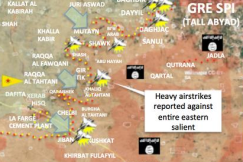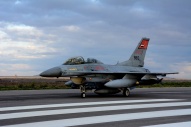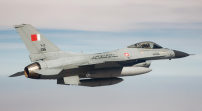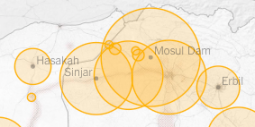Airpower vs ISIS | Jordan |UAE | Videos
This was a section I started back in 2015, but I ran out of steam
 5mar15 Update — Airstrikes against ISIS oil facilities are clearly having an effect, cutting the group’s financial resources and limiting its options, say analysts. McClatchy News Service reports that:
5mar15 Update — Airstrikes against ISIS oil facilities are clearly having an effect, cutting the group’s financial resources and limiting its options, say analysts. McClatchy News Service reports that:
The coalition air campaign that’s targeting its oil-refining operations and military assets has begun to damage its ability to earn… And by denying the group additional territorial expansion, the airstrikes have limited the opportunities for it to profit from capturing new infrastructure and banks.
For more detail, the McClatchy article cites a Financial Action Task Force study describing the sources of ISIS funding. Also, this article on oil smuggling into Turkey is interesting.
2mar15 Update — The coalition may be backing off plans to retake Mosul this spring. The Iraqi army is still not seen as ready for such a major operation, which may delay the operation until late in 2015. In the meantime, the US military is considering how to use air power to degrade ISIS in Mosul. This from a new WSJ piece is out (by Julian Barnes):
Under the evolving plan, the U.S. would use its air power in the coming months to further isolate Mosul and weaken the hold of Islamic State fighters on the city. Under this approach, U.S. airstrikes would be focused on picking off Islamic State leaders to undermine their ability to command and control their forces.

1mar15 Update — The US-led coalition said it conducted 20 airstrikes on 27 & 28 feb, with targets in Iraq and Syria. Several of the strikes were in the vicinity of Kobane. A look at Chuck Pfarrer’s latest Kobane Battle Map helps explain the air activity. As Kurdish forces push east and south into ISIS strongholds, ISIS is pushing back resulting in increased ground fighting. Coalition airstrikes are hitting ISIS concentrations in those areas.
27feb15 Update — Nothing further on al-Baghdadi’s rumored demise, so I’m assuming that didn’t happen. But, another Reuters piece is reporting the Kurds have taken control of Tel Hamis, near Hasakah in the NE corner of Syria. Again, Kurdish sources say coalition airstrikes supported the operations in that key area. This is another key position along the main supply routes/LOCs between ISIS positions in Syria and Iraq.
 26feb15 Update — Reports circulating this morning that ISIS leader Abu Bakr al-Baghdadi may have been killed in an airstrike near Al-Qaim, Iraq. But info is still very sketchy. Reuters reports 17 ISIS militants were killed overnight, and has a local source saying al-Baghdadi was seen in the area right before the strike. Here’s an excerpt:
26feb15 Update — Reports circulating this morning that ISIS leader Abu Bakr al-Baghdadi may have been killed in an airstrike near Al-Qaim, Iraq. But info is still very sketchy. Reuters reports 17 ISIS militants were killed overnight, and has a local source saying al-Baghdadi was seen in the area right before the strike. Here’s an excerpt:
The hospital source in al-Qaim, a town on the Euphrates River, hospital said nine civilians were killed and 29 militants were wounded in the strike by the U.S.-led coalition which is bombing Islamic State targets in Iraq and Syria. Some of the wounded were taken across the border to Syria for treatment. The militants were on their way to reinforce IS fighters on the frontlines in Iraq and were resting at a guesthouse after crossing over from Syria when they were hit, said the hospital source, who overheard conversations between the wounded.
Media reports have killed off al-Baghdadi a few times before, so don’t hold your breath this time. But this does show the increasing effects of the coalition air campaign on ISIS freedom of movement, and how air power is shaping the battlefield. See Making sense of coalition airstrikes against ISIS.
 24feb15 Update — There’s a pretty good piece on Vox.com, laying out the case that ISIS is losing, and one of the main reasons is the coalition air campaign. According to Vox:
24feb15 Update — There’s a pretty good piece on Vox.com, laying out the case that ISIS is losing, and one of the main reasons is the coalition air campaign. According to Vox:
No one expects airstrikes to collapse ISIS on their own. But they’ve been extraordinarily effective at blunting ISIS’s ability to launch offensives in Iraq and Syria. Large masses of ISIS troops, required for such offensives, are really easy to target from the air.
“Their freedom of movement, even within their own territory [in Syria], has been significantly affected” by the strikes, Abbas says. “Before, they could send a group of elite fighters to al-Hasakah in the east, fight there for a couple of days, take territory, and retreat and go and fight in Deir ez-Zor.”
ISIS “relied heavily” on fast movement of elite forces for military success in both Iraq and Syria, according to Abbas. That tactic “has been taken away from them.”
Moreover, US and allied air strikes have been effective at aiding ground operations against ISIS. This was most most obviously true in Kobane, where a barrage of US airstrikes was critical to the Kurdish defense’s success. The strikes have also helped the Iraqi and Kurdish advances in Iraq.
Gotta say, I mostly agree, but it brings up the politics (in US domestic terms) surrounding the air campaign and its effectiveness. More on that later…
 23feb15 Update — Latest advance by the YPG (Syrian Kurdish militia) against ISIS was supported by coalition airstrikes. Kurdish official says YPG fighters gave coordinates of ISIS targets, using the same method used to call in air strikes in the battle for Kobani.
23feb15 Update — Latest advance by the YPG (Syrian Kurdish militia) against ISIS was supported by coalition airstrikes. Kurdish official says YPG fighters gave coordinates of ISIS targets, using the same method used to call in air strikes in the battle for Kobani.
Reuters reports the YPG forces were within 3 miles of Tel Hamis, an ISIS-held town 22 miles SE of Qamishli.
 w Update — France’s aircraft carrier Charles de Gaulle is about to take up station in the Persian Gulf, and likely will soon begin launching airstrikes into Syria and Iraq against ISIS positions, according to press. So far, France has mostly conducted ISR missions as part of Operation Inherent Resolve.
w Update — France’s aircraft carrier Charles de Gaulle is about to take up station in the Persian Gulf, and likely will soon begin launching airstrikes into Syria and Iraq against ISIS positions, according to press. So far, France has mostly conducted ISR missions as part of Operation Inherent Resolve.
20feb15 Update — Coalition airpower has reportedly helped Kurdish YPG fighters and their allies in Kobane turn to the offensive, taking back numerous villages from ISIS control. In the last few days, they have even pushed into the Raqqa Governate (province) the main ISIS stronghold, according to Kurdish sources. Coalition airstrikes reportedly have significantly aided their advance. The map below shows estimated Kurdish positions (in green), based on unverified media info. Black line is limit of Raqqa Governate.
Aha! Found more authoritative maps than my attempt. Here’s one by Chuck Pfarrer, see his most current Kobane Battle Map here.
19febUpdate — Saudi Prince Faisal publicly slammed the air campaign against ISIS today, in an interview with NPR. Quoth the prince, “You really have two air force coalitions – one operating in Syria, not crossing the border into Iraq. The other operating in Iraq, not crossing the border into Syria… Totally insane.”
18feb15 Update — The B-1B Lancer, designed as a strategic bomber, is playing a key role in the air campaign against ISIS. A recent WSJ article describes how the 9th Bomb Squadron helped the Kurds retake Kobane. Gives important new perspectives on how air ops are being run. See details & commentary…

17feb15 Update — The Egyptian Air Force sent aircraft (numbers, types still TBD) against ISIS targets in eastern Libya yesterday, according to ABC News and other media reports. The strikes were retaliation for the beheading of 21 Egyptian Christians by ISIS militants over the weekend. Egypt released details of the mission, the 1st time it has acknowledged a military role in Libya. 64 ISIS fighters were reported killed.
Technically, the Egyptian strikes were not coordinated with Operation Inherent Resolve, the air campaign led by the US. A senior defense official said, “This was not a coalition strike. This was a decision made by the Egyptian government and I have seen no indication the U.S. was involved in any way.” Other US officials told ABC news they were unaware of any prior warning the Egyptians may have given to the U.S. before striking ISIS targets in Libya.
But Egypt’s operation does show a widening of the overall conflict against the Islamic State and of the air component of that fight. Egypt is officially part of the anti-ISIS coalition, but its aircraft have not yet participated in missions over Iraq or Syria.
 15feb15 Update — Bahrain has also now sent combat aircraft (most likely F-16s) to Jordan to participate in attacks against ISIS, according to Reuters. The Bahrani Royal Air Force (BRAF) joins the UAEAF on the front lines of the air campaign.
15feb15 Update — Bahrain has also now sent combat aircraft (most likely F-16s) to Jordan to participate in attacks against ISIS, according to Reuters. The Bahrani Royal Air Force (BRAF) joins the UAEAF on the front lines of the air campaign.
12feb15 Update — On 11feb UAEAF F-16s flew missions against ISIS from base in Jordan. Also, role of the F-22 in air campaign becomes more apparent. Raptors escorting Jordanian strikers, using their advanced EW capabilities to support strike packages.
8feb15 Update — UAEAF Block 60 F-16s and other aircraft have arrived in Jordan.
7feb15 Update — UAE sending a squadron of F-16 E/Fs to Jordan to help in campaign against ISIS.
6feb15 Update — ISIS claims American female hostage was killed by Jordanian airstrikes. Claim being investigated. Jordanian aircraft hit ISIS targets for second day, this time in Iraq, with top-cover by USAF F-22s.

5feb17 — Right now the world’s most significant combat employment of air power is the ongoing coalition effort against the Islamic State in Iraq & Syria (aka ISIS or ISIL). And after the brutal murder of the Jordanian F-16 pilot Moaz al-Kasasbeh I anticipate air attacks against ISIS will accelerate–with or without the US.
The air campaign against ISIS is called Operation Inherent Resolve (OIR) and here’s the Department of Defense website that’s putting out daily information, photos, videos, etc. for the media and the public.
 Here’s a quick-look at where the coalition airstrikes have occurred, and how many there have been (through Dec 2014). You can see right away that most sorties have hit targets around Kobane, Syria.
Here’s a quick-look at where the coalition airstrikes have occurred, and how many there have been (through Dec 2014). You can see right away that most sorties have hit targets around Kobane, Syria.
How the Air Campaign Against ISIS Grew, NY Times info-graphic, 31dec2015
More references:
ISIS is losing, Vox.com, 23feb15
How 6 months of airstrikes have hurt ISIL, Breaking Defense, 11feb15
Jordan’s King Wants to Go After ISIS, Foxtrot Alpha blog, 6feb15
ISIL hated Kassesbeh because airstrikes work, Al Jazeera, 5feb15
ISIS fighters say airstrikes drove them out of Kobani, CNN, 31jan15
Too soon to say ‘mission accomplished’ in Kobani, Reuters, 27jan15
Air strikes killed 6,000 ISIS fighters: US Ambassador, Al Arabiya, 22jan15
AF mission against IS: Slow the advance, Air Force Times, 15jan15
Operation Inherent Resolve: Interim Assessment, Washington Inst., 13jan15
The War against ISIS Oil Network, Jamestown Foundation, 9jan15
List of ISIS targets destroyed since August, Business Insider, 7jan15
Humvees, Tanks Oil: ISIL Targets Hit, Breaking Defense, 7jan15
5 Months of Air Strikes in 4 Charts, defenseone.com, 8jan15
Prominent ISIS leader killed in Kobani (by airstrike), Rudaw.net, 2jan15
Coalition partnerships key in OIR, Air Force Times, 19dec14
Coalition Executes 1,000 Airstrikes against ISIS, military.com, 26nov14
US Shouldering Brunt of ISIS Air Campaign, Boston Globe, 10nov14
UK Reaper UAV flies 1st Iraqi strike mission, Janes.com, 10nov14
Obstacles Limit Targets & Pace of Strikes on ISIS, NY Times, 9nov14
US-led Airstrikes on Islamic State pick up, Chicago Tribune, 15oct14
General Deptula Challenges Pentagon on ISIS, TIME, 9oct14
US military: Airstrikes won’t save key city of Kobani, CNN, 9oct14
Behind Air Strikes On ISIS, Lexington Institute, 03oct14
Air Campaign against ISIS to target leaders, NBC News, 12sep14
Iraq Airstrikes are Strategic, not Humanitarian, Breaking Defense, 31aug14

3 thoughts on “Airpower vs ISIS”